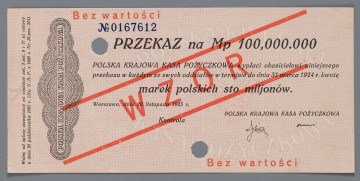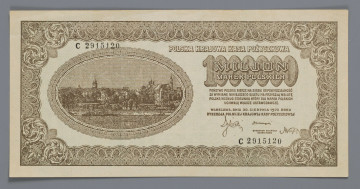
Cheque for 100,000,000 Polish marks - a template
1923
National Museum in Lublin
Part of the collection: Paper money during the Second Polish Republic
The 5 million Polish mark (mkp) was one of the highest denominations during the period of hyperinflation in Poland in the interwar period. The depreciation of the mkp, which had been progressing since the autumn of 1923, led within a few months to the collapse of this currency, marked by an increase in the price of the dollar by nearly 22,000 percent. These were the last months of the Polish mark and the Polish National Loan Fund (PKKP) issuing it - an occupation institution which had been polonised in 1918 and whose place, after the economic situation had stabilised, was to be taken by Bank Polski with the zloty as the national currency.
With the collapse of the PKKP, the economic situation collapsed, inflation leading to a severe fall in real wages. Already in the third quarter of 1923, more than 250,000 workers went on strike, and at the beginning of November, a general strike broke out, which took a dramatic course in the Małopolska region. In Kraków, clashes between the protesters and the army were attended by loss of life. Fueled by the left-wing, communist opposition, public sentiment was calculated to unbalance the state and spark a revolution to seize power. There was also uproar in neighbouring countries. That hot autumn saw communist revolts in Bulgaria and Hamburg, as well as Adolf Hitler's Munich putsch (8 November).
The currency reform in Poland, which had been postponed until the budget was balanced, therefore had to be implemented in conditions of deep economic and social crisis. Its author was the eminent economist Władysław Grabski (1874-1938), twice Prime Minister (June-July 1920, December 1923-November 1925) and Minister of the Treasury on several occasions. Using both the law already enacted and the power to issue decrees with the force of law, a wealth tax was introduced, taxes were revalued, public spending was reduced and the subsidising of the railways was abandoned. Credit for state expenditure from the issue of PKKP mkp was also abandoned. Only after these steps had been taken did stock exchange intervention stop the currency's decline in February. The 5 million mkp banknote introduced into circulation on 10 January 1924 still lost about fifty per cent of its value in January.
The denomination made it possible to pay for almost a quarterly subscription to "Kurier Warszawski", with personal collection in the capital. In its pages, an overcoat was offered for 100 million mkp, and a "little-used" men's fur coat for 200 million.
Tomasz Markiewicz
Author / creator
Dimensions
cały obiekt: height: 168 mm, width: 81 mm
Object type
paper money
Technique
Material
paper
Creation time / dating
Creation / finding place
Owner
The National Museum in Lublin
Identification number
Location / status

1923
National Museum in Lublin

1923
National Museum in Lublin

1923
National Museum in Lublin
DISCOVER this TOPIC
National Museum in Szczecin
DISCOVER this PATH
Educational path